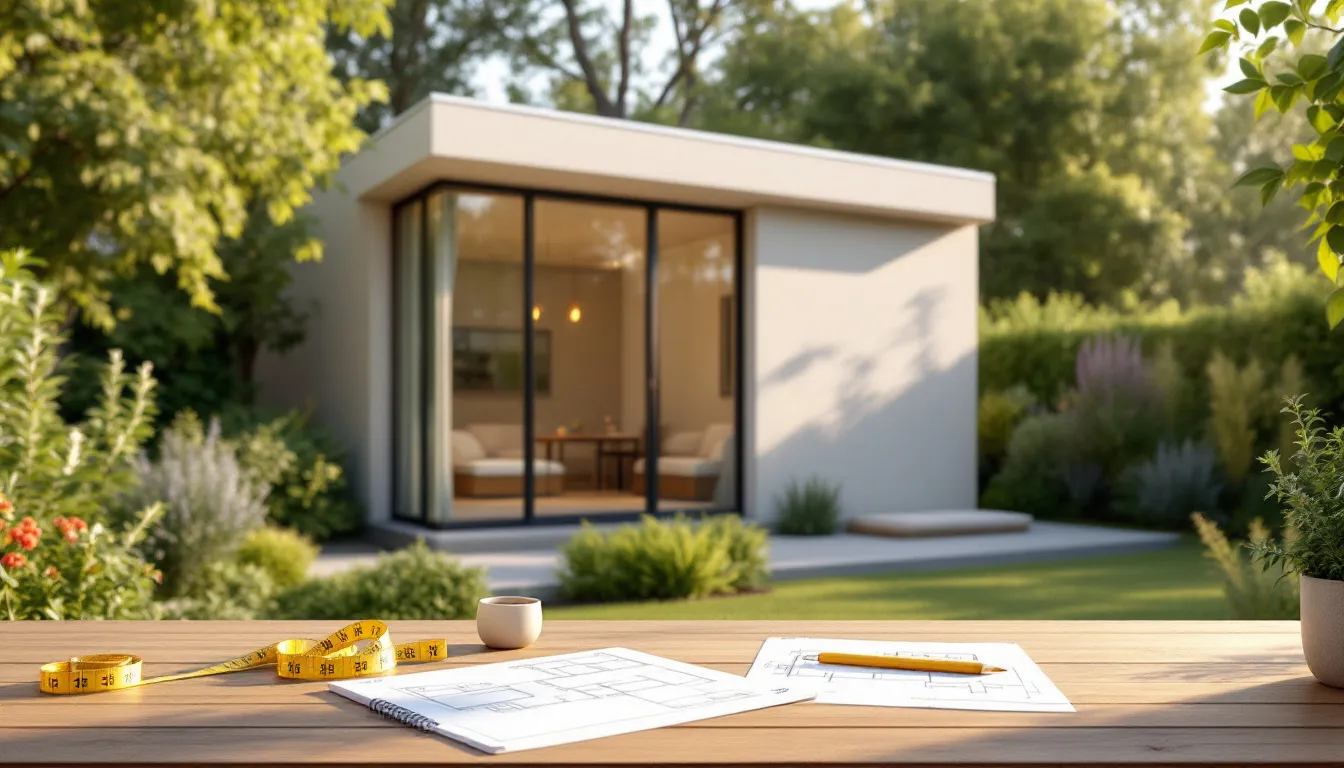Planning to build an ADU? Here's how to avoid common pitfalls:
- Weather-proof your timeline: Add 10-15% extra time to your schedule for unexpected delays.
- Pad your budget: Set aside 10-20% of total costs for surprises.
- Build in time buffers: Plan extra time for site prep, framing, utilities, and finishing work.
- Navigate permit issues: Research local rules, consider prefab options, and build relationships with city officials.
- Secure materials early: Find backup suppliers, buy materials in advance, and cultivate good supplier relationships.
Why this matters:
- Saves money
- Keeps projects on track
- Reduces stress
Remember: ADUs often cost more and take longer than expected. But with smart planning, you can handle challenges smoothly and build a successful ADU.
Related video from YouTube
Plan for Weather Delays
Mother Nature doesn't care about your ADU project timeline. But you can outsmart her. Here's how to handle those weather setbacks:
Pick the Right Season
Timing matters. Summer and early fall usually offer the best building conditions. But do your homework.
Building in Seattle? Avoid November through January. These months average 5.5 inches of rain each. That's a recipe for mud and delays!
Add Extra Time
Here's a pro tip: Pad your schedule.
Why? Hyphen Solutions, a construction management software company, says it straight: "Bad-weather delays are unavoidable in residential construction."
How much extra time? Add 10-15% to your project timeline. For a 3-month ADU build, that's about 9-14 extra days. Seems like a lot, but you'll be glad you did.
Bad Weather Building Options
Rain doesn't mean you have to stop. Try these workarounds:
- Prefab components: Use pre-made walls or roof trusses. Install them quickly when the weather clears.
- Temporary shelters: Get heavy-duty tarps or a temporary structure to cover your work area.
- Indoor tasks: Do interior work like electrical or plumbing rough-ins on bad weather days.
Be flexible. A project manager at a top California ADU builder told me: "We always have a 'Plan B' task list for rainy days. It keeps the project moving and the crew busy."
Set Aside Extra Money
Building an ADU can be a financial rollercoaster. Here's how to keep your wallet happy when surprises pop up.
Save a Set Amount
The golden rule? Stash away 10-20% of your total budget for the unexpected. In the ADU world, surprises are the norm.
Let's crunch some numbers:
- $200,000 ADU project? Set aside $20,000 to $40,000 extra.
- Working with $100,000? Aim for $10,000 to $20,000 in reserve.
These aren't random figures. Abodu, a top ADU builder, warns:
Going over your projected timeline means having to pay more than you initially expected. This is one of the most common ways ADU constructions go over budget.
Watch for Cost Risks
Keep an eye out for these budget-busters:
1. Utility upgrades
Upgrading to a 200-amp electrical panel? That's a few thousand dollars right there.
2. Site work
Removing trees or leveling land? Your wallet might feel the pinch.
3. Material price hikes
Lumber prices can go wild. Recent tariffs on Canadian lumber have sent prices through the roof.
Caitlin Bigelow, CEO of Maxable, doesn't sugarcoat it:
A lot of people have sticker shock when they see it will cost $200,000.
Don't be one of those people. Be prepared.
Handle Price Changes
When material costs skyrocket, here's how to stay grounded:
1. Talk to your contractor
Get their take on price trends. They know the market pulse.
2. Lock in prices early
Can you buy materials in advance when prices are low? Do it.
3. Be flexible
Fancy tile or essential lumber? Choose wisely if prices spike.
4. Consider timing
Building off-season might score you better deals on materials and labor.
It's not just about having extra cash. It's about being smart with it. Jared Basler from Casita Coalition offers this nugget of wisdom:
If you're not prepared to possibly pay $10,000 in D&I fees, don't build larger than 750 square feet.
Smart advice for smart builders. Now, go forth and build that ADU - with your financial safety net firmly in place.
sbb-itb-4e754d1
Build Time Buffers
Building an ADU is like a marathon, not a sprint. You need to plan for unexpected hurdles. Here's how to make your schedule flexible enough to handle curveballs.
Key Project Steps
Every ADU project has its own rhythm, but some steps often need extra time:
1. Site Preparation
This can take longer than expected, especially if you hit snags like poor soil or hidden utility lines.
2. Framing
Weather can mess with your timeline here. A few rainy days can easily stretch this phase.
3. Utility Installation
Getting inspections and hooking up services often means waiting on others. Give yourself some wiggle room.
4. Finishing Work
This is where details matter, and details take time. Don't rush the final touches.
Richard Garrett, founder of RG ProBuilders, says:
"Partnering with a seasoned contractor can be the key to solving zoning mysteries and successfully navigating the permit process."
He's spot on. A good contractor isn't just about construction - they're your guide through the bureaucratic maze.
Work with Contractors
Here's how to keep your contractors on track:
- Set up weekly check-ins. Catch small delays before they become big problems.
- Consider offering a bonus for on-time or early completion. It's a powerful motivator.
- If one trade is running late, see if another can start early. This flexibility can save you time.
Remember, your contractor is juggling multiple jobs. Be understanding, but firm.
Plan for Late Deliveries
Late materials can derail your project. Here's how to stay ahead:
- Order materials as soon as your plans are finalized. This gives you a buffer for shipping delays.
- Know your second and third choice suppliers for critical items. If your first choice falls through, you can pivot quickly.
- If you can safely store materials on-site, do it. It's better to have them early than scrambling at the last minute.
In Los Angeles, where ADU construction is booming (over 5,000 permits issued in 2019 alone), many builders face supply chain issues. One effective strategy? Building relationships with local suppliers. They're more likely to prioritize your orders if you're a regular customer.
Handle Permit Issues
Getting permits for your ADU can be a pain. But don't worry - with the right approach, you can avoid major headaches. Let's look at how to tackle those permit problems head-on.
Common Permit Delays
What slows down the permit process? Here are the usual suspects:
- Incomplete applications
- Code compliance issues
- Utility complications
Sean Phillips from Otto ADU points out:
Utility complications can arise, such as needing to upgrade the electrical panel or water line to support the ADU, which can add significant costs.
Want to avoid these issues? Do your homework. Visit your local building department before you start. Ask about specific requirements for your project. This simple step can save you a ton of time later.
Smart Ways to Meet Rules
Sometimes, you need to think outside the box to meet building codes. Here are some clever tactics:
Consider prefab options. Some cities have fast-track programs for pre-approved ADU designs. In Danville, this can cut approval time to just 4-6 weeks.
Explore variances. If your project doesn't quite fit the rules, you might be able to get an adjustment. In Portland, this process takes about 8-10 weeks.
Look into amnesty programs. Some cities offer limited-time programs to legalize existing unpermitted ADUs. This can save you on fees and inspections.
It's not just about following rules. It's about finding smart ways to work within them.
Talk to City Officials
Building a good relationship with your local permit office can make a huge difference. Here's how to do it:
Meet face-to-face. Many cities offer free 15-minute appointments with planners. Use these to get clarity on tricky issues.
Be prepared. Bring detailed plans and questions. Show them you've done your research.
Stay positive. Even if you hit a roadblock, keep a collaborative attitude. These officials can be your best allies.
Gordon Stott from Connect Homes offers this advice:
You need to go out and do your due diligence and understand what logistically you need to upgrade on your site.
In Calistoga, they process ADU applications in just 30 days. This shows what's possible when cities prioritize ADU development.
Get Materials on Time
Getting your supplies when you need them can make or break your ADU project. Here's how to keep your materials flowing smoothly.
Backup Supply Sources
Don't rely on just one supplier. Having multiple options can save you when things go wrong.
In 2021, lumber prices jumped 300% due to supply chain problems. Builders with multiple supplier relationships could adapt quickly, saving time and money.
Greg Popovich from Goldbar Builders says: "Delays are going to happen no matter what you do, and trust us, no one is more frustrated about it than your ADU builder."
To avoid these issues:
- Find local and online suppliers for each major material
- Check prices and delivery times
- Keep 2-3 backup options for critical items
Buy Early
Getting materials early can be a smart move:
- You lock in prices before potential increases
- You avoid delays from sudden shortages
- You have time to check materials and replace any bad ones
But where do you store everything? If you have the space, think about renting a storage container. For $100-$200 a month, you can keep your materials safe and dry on your property.
Build Good Supplier Relations
Your suppliers can be your secret weapon. Treat them well, and they'll have your back when you need it. Here's how:
1. Communicate clearly
Tell them exactly what you need and when you need it.
2. Pay promptly
Being reliable with payments builds trust.
3. Show appreciation
A simple "thank you" goes a long way.
One California ADU builder said that by building strong relationships with local suppliers, they got hard-to-find materials during the 2021 supply chain crisis. This kept their projects moving while others stalled.
Conclusion
Building an ADU is exciting, but it comes with challenges. Planning for problems sets you up for success. Here's why being prepared matters:
It saves you money. Unexpected issues can drain your budget fast. Set aside 10-20% of your total costs as a contingency fund. This cushions you against financial surprises.
It keeps your project on track. Time is money in construction. Build time buffers into your schedule. This helps you stay on course even when delays happen.
It cuts stress. When you're ready for hiccups, you can handle them calmly. This makes the whole process smoother for you and your team.
Good planning is key. The Cottage team says, "These five pieces of advice drive the majority of our successful projects." From getting your budget ready early to talking often with your ADU team, every prep step pays off.
Don't skip the legal stuff. All ADUs need proper permits, and rules can be very different in different areas. Do your research or get an expert to help you navigate this.
Be flexible. Greg Popovich from Goldbar Builders says, "Delays are going to happen no matter what you do." What matters is how you deal with them. Stay positive, keep talking, and trust your team.
With these tips, you're ready to tackle your ADU project. It might be tough at times, but a well-built, functional ADU is worth the effort. Good luck with your build!


